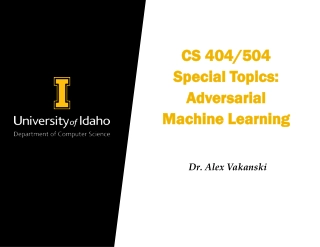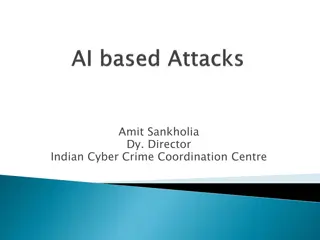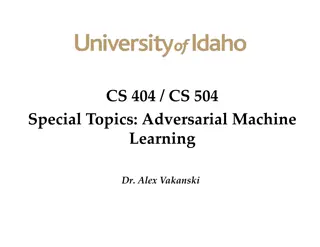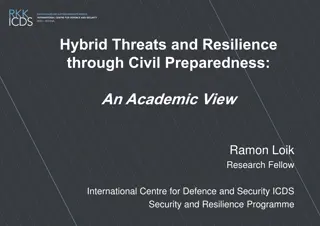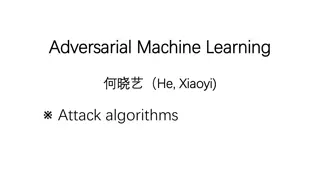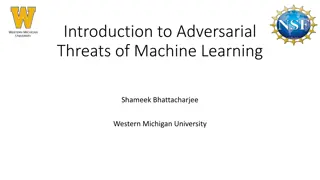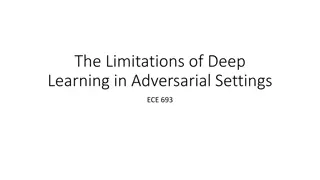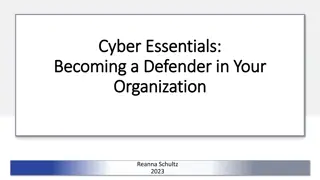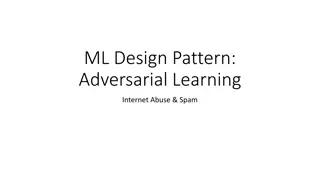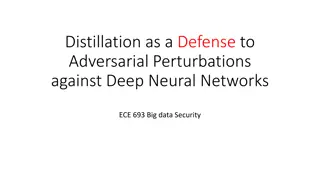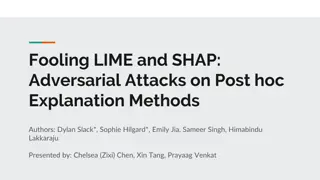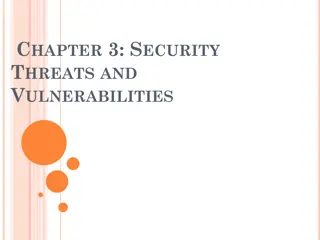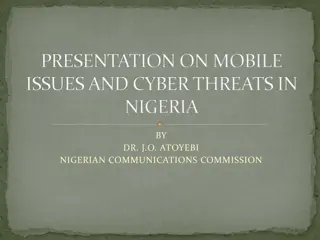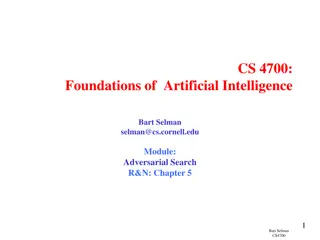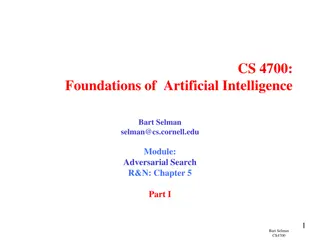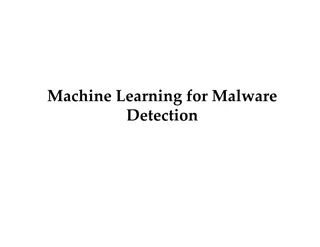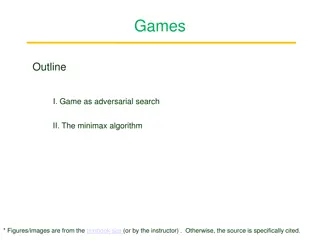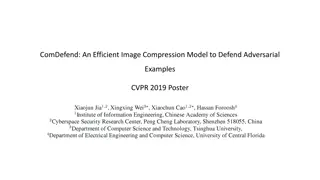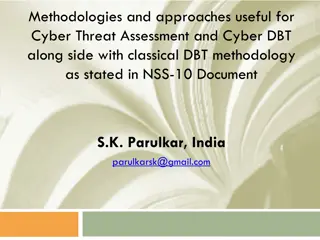Adversarial Machine Learning in Cybersecurity: Challenges and Defenses
Adversarial Machine Learning (AML) plays a crucial role in cybersecurity as security analysts combat continually evolving attack strategies by malicious adversaries. ML models are increasingly utilized to address the complexity of cyber threats, yet they are susceptible to adversarial attacks. Inves
2 views • 46 slides
Understanding Malicious Attacks, Threats, and Vulnerabilities in IT Security
Malicious attacks, threats, and vulnerabilities in IT systems pose significant risks and damages. This chapter explores the types of attacks, tools used, security breaches, and measures to protect against cyber threats. Learn how security professionals safeguard organizations from malicious attacks
0 views • 24 slides
TEAM SWOT ANALYSIS
This comprehensive presentation template guides individuals or small groups through conducting a SWOT analysis to identify strengths, weaknesses, opportunities, and threats for a business. It includes questions to assess strengths, weaknesses, opportunities, and threats, a discussion section to dete
1 views • 8 slides
CS 404/504 Special Topics
Adversarial machine learning techniques in text and audio data involve generating manipulated samples to mislead models. Text attacks often involve word replacements or additions to alter the meaning while maintaining human readability. Various strategies are used to create adversarial text examples
1 views • 57 slides
Artificial Intelligence in Cyber Security: Enhancing Threat Detection and Response
Artificial Intelligence (AI) is revolutionizing cyber security by enhancing threat detection, response, and prevention capabilities. By leveraging machine learning algorithms, AI enables organizations to identify cyber threats, analyze behavioral patterns, automate incident response, adapt to evolvi
1 views • 33 slides
Comprehensive Digital Risk Assessment Guide for Businesses
Conducting a digital risk assessment is vital for securing your business against threats like viruses, malware, hackers, and human errors. This guide outlines key areas to focus on, such as identifying critical assets, assessing potential impacts of breaches, prioritizing threats, utilizing tools li
3 views • 4 slides
Understanding Threats in Distribution Integrity Management Program
Distribution Integrity Management Program (DIMP) focuses on ensuring the integrity of pipelines by understanding and managing various threats. Operators are responsible for identifying, categorizing, and addressing potential threats such as corrosion, natural forces, excavation damage, and more to p
1 views • 39 slides
Healthcare Executive's Guide to Ransomware Threats
This comprehensive guide covers essential information on ransomware threats in healthcare, including the definition of ransomware, how it works, email and network threats, and statistics. Gain insights from Troy Ament, a seasoned CISO in the healthcare sector, to safeguard your organization against
0 views • 17 slides
Exploring Adversarial Machine Learning in Cybersecurity
Adversarial Machine Learning (AML) is a critical aspect of cybersecurity, addressing the complexity of evolving cyber threats. Security analysts and adversaries engage in a perpetual battle, with adversaries constantly innovating to evade defenses. Machine Learning models offer promise in combating
0 views • 43 slides
Cyber Threats and Security Controls Analysis for Urban Air Mobility Environments
The Urban Air Mobility (UAM) environment, with its service-oriented architecture, faces various cyber threats related to end-users, cyber-physical systems, cloud services, and on-premise computing. Threats include unauthorized interception of data, phishing attacks, and Denial of Service (DoS) incid
2 views • 9 slides
Understanding Hybrid Threats and Resilience through Civil Preparedness
Exploring the concept of hybrid threats that combine external threats and internal vulnerabilities, this academic viewpoint by Ramon Loik emphasizes the importance of civil preparedness in building resilience against crises. It delves into aspects such as target selection, active influencing, and th
0 views • 11 slides
Understanding Adversarial Attacks in Machine Learning
Adversarial attacks in machine learning aim to investigate the robustness and fault tolerance of models, introduced by Aleksander Madry in ICML 2018. This defensive topic contrasts with offensive adversarial examples, which seek to misclassify ML models. Techniques like Deep-Fool are recognized for
0 views • 29 slides
Understanding Adversarial Machine Learning Attacks
Adversarial Machine Learning (AML) involves attacks on machine learning models by manipulating input data to deceive the model into making incorrect predictions. This includes creating adversarial examples, understanding attack algorithms, distance metrics, and optimization problems like L-BFGS. Var
0 views • 88 slides
Understanding Adversarial Threats in Machine Learning
This document explores the world of adversarial threats in machine learning, covering topics such as attack nomenclature, dimensions in adversarial learning, influence dimension, causative and exploratory approaches in attacks, and more. It delves into how adversaries manipulate data or models to co
0 views • 10 slides
Limitations of Deep Learning in Adversarial Settings
Deep learning, particularly deep neural networks (DNNs), has revolutionized machine learning with its high accuracy rates. However, in adversarial settings, adversaries can manipulate DNNs by crafting adversarial samples to force misclassification. Such attacks pose risks in various applications, in
0 views • 38 slides
Adversarial Risk Analysis for Urban Security
Adversarial Risk Analysis for Urban Security is a framework aimed at managing risks from the actions of intelligent adversaries in urban security scenarios. The framework employs a Defend-Attack-Defend model where two intelligent players, a Defender and an Attacker, engage in sequential moves, with
1 views • 26 slides
Understanding Cyber Threats and the Role of Defenders in Organizations
Explore the world of cyber threats, including phishing, malware, and data breaches, and understand the importance of being a defender in your organization. Learn about key security mechanics, evolving threats, and the essential role of human vigilance in cybersecurity.
0 views • 17 slides
Adversarial Learning in ML: Combatting Internet Abuse & Spam
Explore the realm of adversarial learning in ML through combating internet abuse and spam. Delve into the motivations of abusers, closed-loop approaches, risks of training on test data, and tactics used by spammers. Understand the challenges and strategies involved in filtering out malicious content
0 views • 13 slides
Distillation as a Defense Against Adversarial Perturbations in Deep Neural Networks
Deep Learning has shown great performance in various machine learning tasks, especially classification. However, adversarial samples can manipulate neural networks into misclassifying inputs, posing serious risks such as autonomous vehicle accidents. Distillation, a training technique, is proposed a
3 views • 31 slides
Understanding Robustness to Adversarial Examples in Machine Learning
Explore the vulnerability of machine learning models to adversarial examples, including speculative explanations and the importance of linear behavior. Learn about fast gradient sign methods, adversarial training of deep networks, and overcoming vulnerabilities. Discover how linear perturbations imp
0 views • 37 slides
Adversarial Attacks on Post-hoc Explanation Methods in Machine Learning
The study explores adversarial attacks on post-hoc explanation methods like LIME and SHAP in machine learning, highlighting the challenges in interpreting and trusting complex ML models. It introduces a framework to mask discriminatory biases in black box classifiers, demonstrating the limitations o
2 views • 18 slides
Essential Tips for Protecting Your Computer from Cyber Threats
Protecting your computer from cyber threats is crucial in today's interconnected world. By installing and regularly updating antivirus software, you can enhance your computer's security and safeguard your data from malicious attacks. Choose the right antivirus software based on recommendations, feat
0 views • 28 slides
Understanding Game Playing and Adversarial Search at University of Berkeley
Delve into the realm of game playing and adversarial search at the University of Berkeley to understand the complexities of multi-agent environments. Explore the concepts of competitive MA environments, different kinds of games, and the strategic decision-making processes involved in two-player game
0 views • 81 slides
Coastal Challenges: Threats and Uses Analysis
The Year 9 Geography homework booklet focuses on the topic of coasts, emphasizing grid references and mapping skills. Students are tasked with identifying grid references for shapes, drawing specific shapes on grids, and demonstrating understanding of 4 and 6 figure grid references. Additionally, in
0 views • 13 slides
Understanding Security Threats and Vulnerabilities in Computer Systems
In computer security, threats exploit vulnerabilities to breach security and cause harm. Vulnerabilities arise from system weaknesses, attacker access, and capability. Threats include spoofing, data tampering, repudiation, information disclosure, denial of service, and elevation of privilege. Catego
0 views • 13 slides
Understanding Zero-Shot Adversarial Robustness for Large-Scale Models
Pretrained large-scale vision-language models like CLIP show strong generalization on unseen tasks but are vulnerable to imperceptible adversarial perturbations. This work delves into adapting these models for zero-shot transferability in adversarial robustness, even without specific training on unk
0 views • 18 slides
Mobile Issues and Cyber Threats in Nigeria - Presentation by Dr. J.O. Atoyebi, NCC
Evolution of GSM in Nigeria, the impact of mobile phone deregulation, and the rise of cyber threats highlighted in a presentation by Dr. J.O. Atoyebi of the Nigerian Communications Commission. The report reveals Nigeria's position in global internet security threats and the challenges faced by the c
0 views • 7 slides
Recognizing and Preventing Insider Threats in National Security
Insider threats pose a significant risk to national security and industry, involving individuals using authorized access to carry out harmful actions. This content covers the definition of insider threats, indicators, consequences, and ways to recognize and report suspicious behaviors. It emphasizes
0 views • 15 slides
Understanding Threat Assessment in Conservation: Direct, Stress, and Indirect Threats
Within threat assessment for conservation, different types of threats are identified and categorized, including direct threats which are human-induced actions directly affecting conservation targets, stressors which result from biophysical impacts of actions on targets, and indirect threats contribu
0 views • 24 slides
Evaluating Adaptive Attacks on Adversarial Example Defenses
This content discusses the challenges in properly evaluating defenses against adversarial examples, highlighting the importance of adaptive evaluation methods. While consensus on strong evaluation standards is noted, many defenses are still found to be vulnerable. The work presents 13 case studies o
0 views • 9 slides
Understanding Cyber Threats in Today's Digital Landscape
Cyberspace is a vast realm encompassing the Internet, where we engage in various activities ranging from communication to entertainment. With the majority of children exposed to the online world, cybersecurity awareness is crucial to tackle the rising cyber threats. These threats include job frauds,
0 views • 33 slides
Understanding Adversarial Search in Artificial Intelligence
Adversarial search in AI involves making optimal decisions in games through concepts like minimax and pruning. It explores the strategic challenges of game-playing, from deterministic turn-taking to the complexities of multi-agent environments. The history of computer chess and the emergence of huma
0 views • 56 slides
Foundations of Artificial Intelligence: Adversarial Search and Game-Playing
Adversarial reasoning in games, particularly in the context of artificial intelligence, involves making optimal decisions in competitive environments. This module covers concepts such as minimax pruning, game theory, and the history of computer chess. It also explores the challenges in developing AI
0 views • 56 slides
Machine Learning for Cybersecurity Challenges: Addressing Adversarial Attacks and Interpretable Models
In the realm of cybersecurity, the perpetual battle between security analysts and adversaries intensifies with the increasing complexity of cyber attacks. Machine learning (ML) is increasingly utilized to combat these challenges, but vulnerable to adversarial attacks. Investigating defenses against
0 views • 41 slides
Understanding Experiments and Threats to Validity
Explore the world of experimental research, internal and external validity, threats to validity, and the importance of proper study design in ensuring the credibility of research results. Learn about confounding variables, threats to internal validity such as environmental factors and group comparis
0 views • 15 slides
Exploring Adversarial Search and Minimax Algorithm in Games
Competitive games create conflict between agents, leading to adversarial search problems. The Minimax algorithm, used to optimize player decisions, plays a key role in analyzing strategies. Studying games offers insights into multiagent environments, economic models, and intellectual engagement. The
0 views • 17 slides
Efficient Image Compression Model to Defend Adversarial Examples
ComDefend presents an innovative approach in the field of computer vision with its efficient image compression model aimed at defending against adversarial examples. By employing an end-to-end image compression model, ComDefend extracts and downscales features to enhance the robustness of neural net
0 views • 16 slides
Navigating Current and Emerging Cyber Threats: Leadership Insights
Delve into the realm of current and emerging cyber threats with a focus on leadership considerations. Understand the evolving landscape of cyber risks, the importance of cyber expertise in leadership planning, and the essential role of cybersecurity in today's digital world. Explore the various thre
0 views • 16 slides
Understanding Threats and Attacks in Information Systems
Threats and attacks pose risks to information systems through vulnerabilities that can be exploited, leading to data loss, system unavailability, and compromised security. Four primary classes of threats include unstructured threats from inexperienced individuals, structured threats from skilled hac
0 views • 21 slides
Comparison of Traditional and Cyber Threat Assessment Methodologies
In the digital age, understanding cyber threats alongside traditional threats is crucial. Cyber adversaries operate globally and are hard to identify, posing challenges for intelligence agencies. The ease of acquiring cyber skills and resources makes cyber threats dynamic and dangerous. Classical cy
0 views • 17 slides
